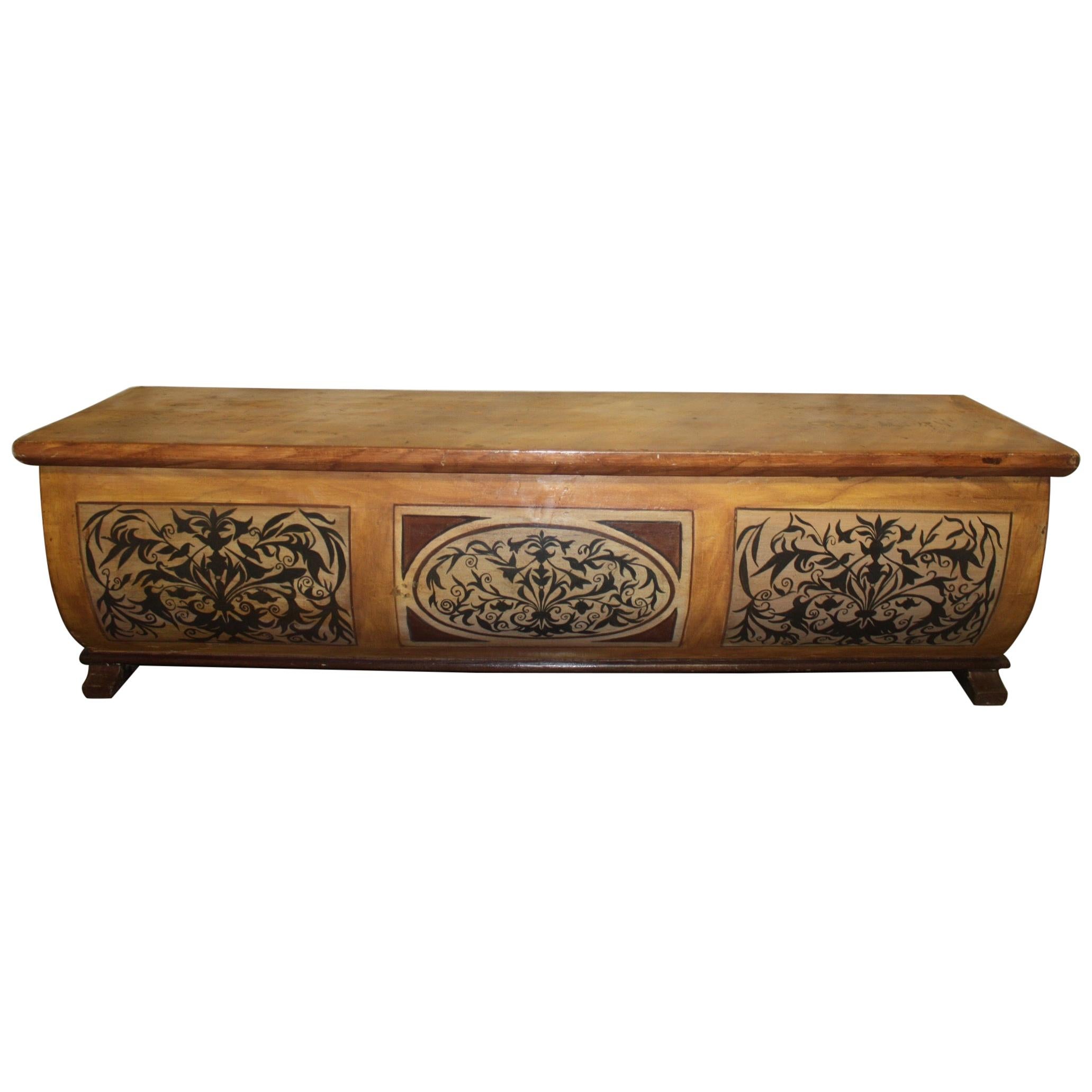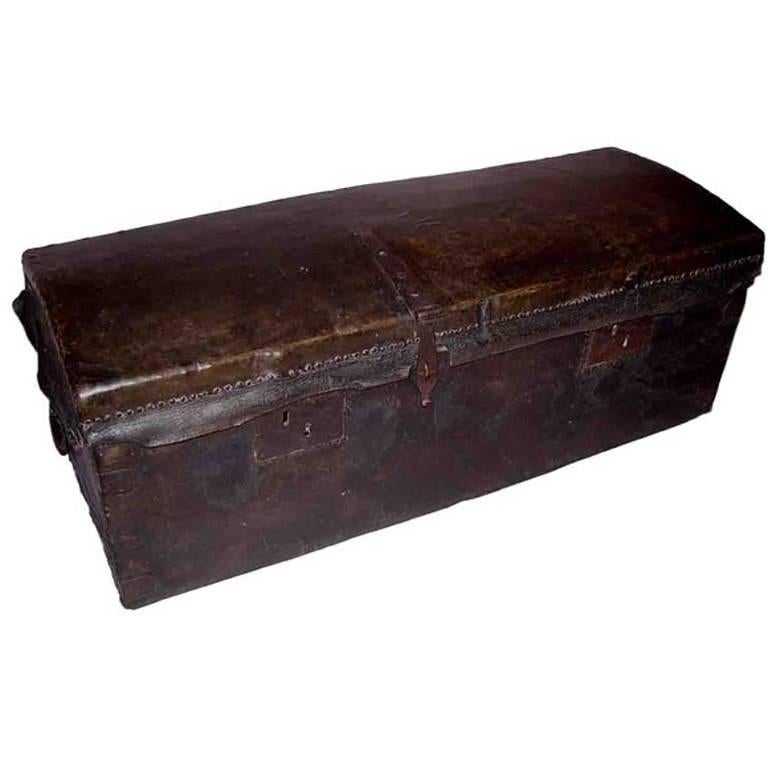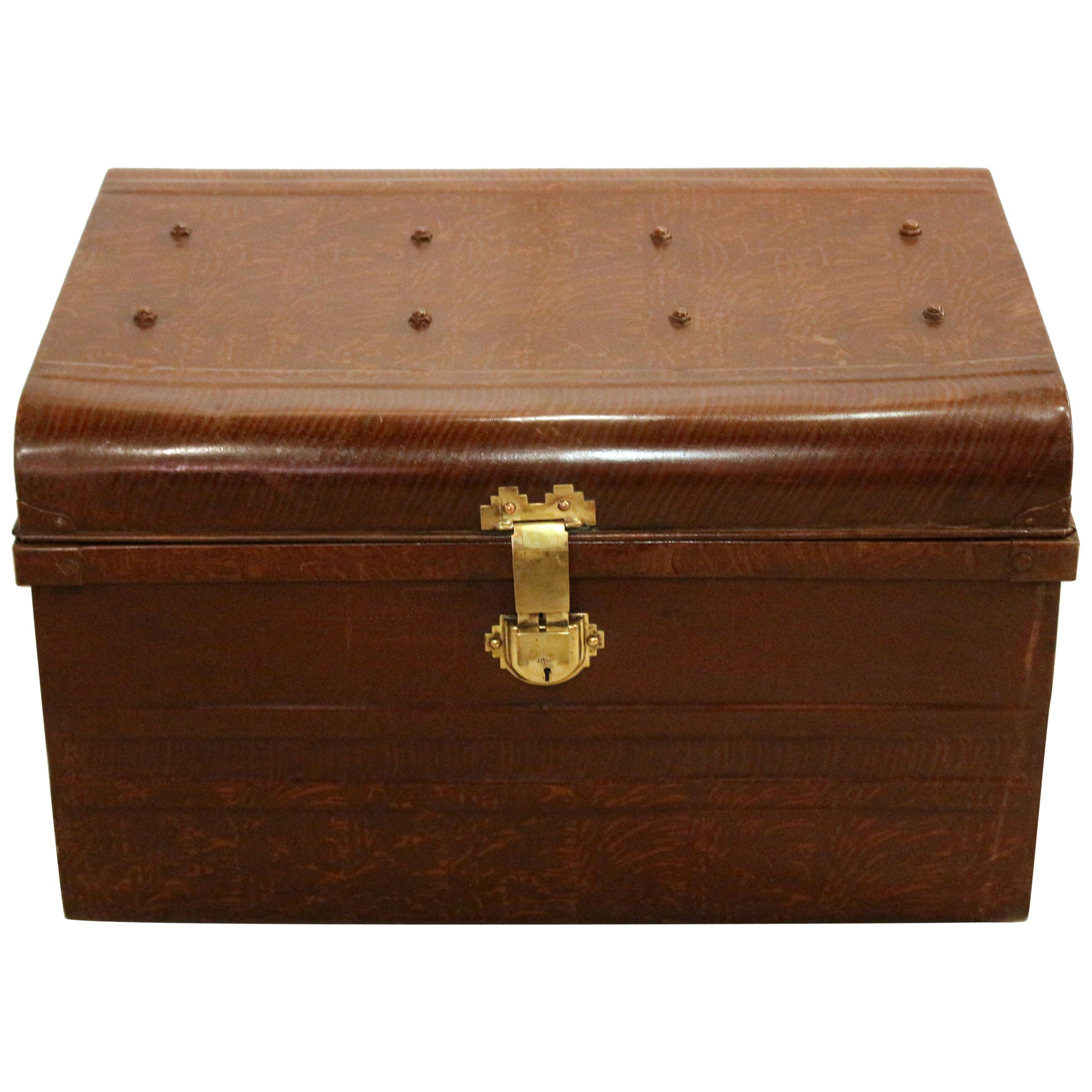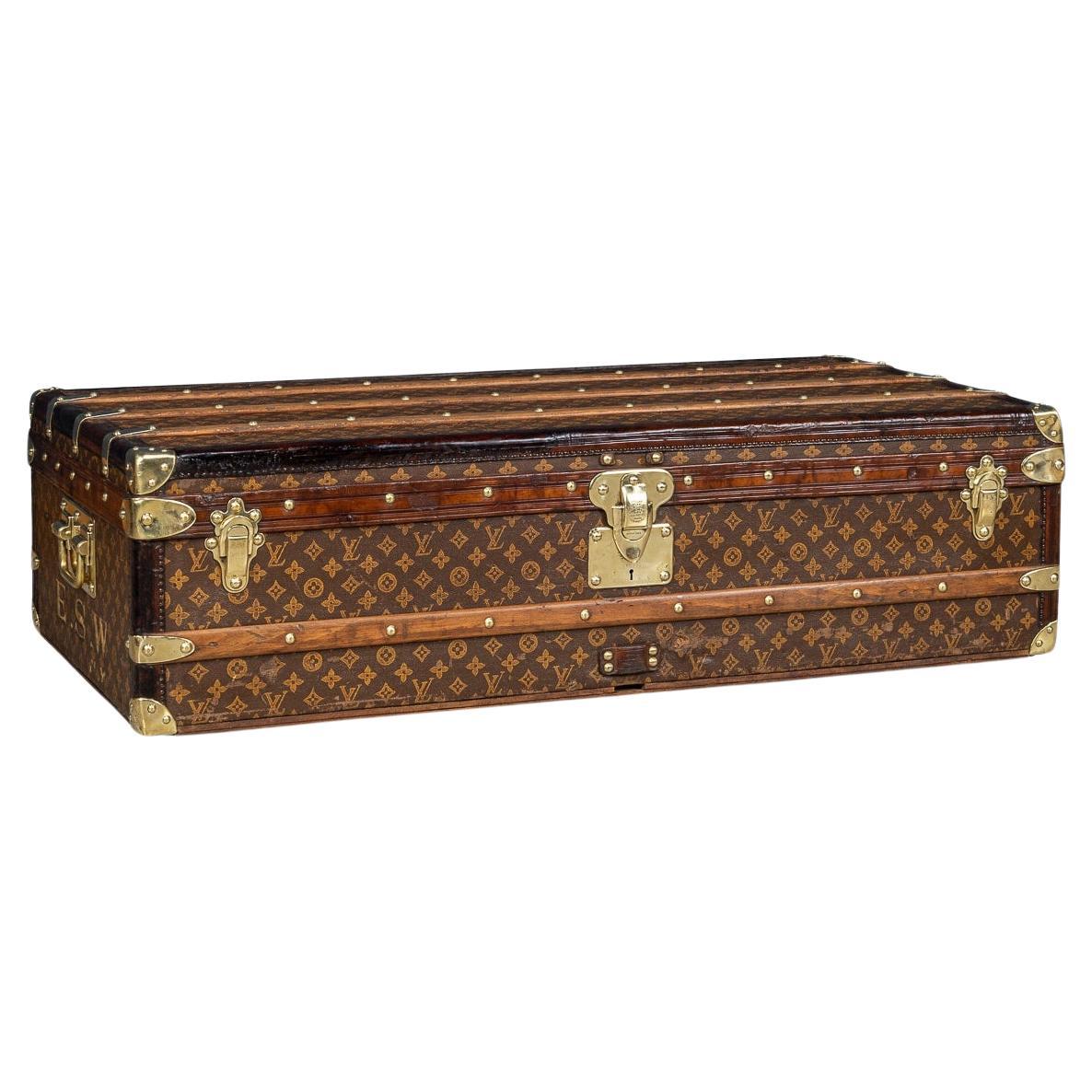
20th Century Childs Traveling Trunk, c.1920
View Similar Items
Want more images or videos?
Request additional images or videos from the seller
1 of 21
20th Century Childs Traveling Trunk, c.1920
About the Item
- Dimensions:Height: 10.24 in (26 cm)Width: 17.72 in (45 cm)Depth: 10.24 in (26 cm)
- Materials and Techniques:
- Place of Origin:
- Period:
- Date of Manufacture:circa 1920
- Condition:Wear consistent with age and use. Minor fading. In Good Condition - wear as expected.
- Seller Location:Royal Tunbridge Wells, GB
- Reference Number:Seller: D78711stDibs: LU1348227863562
About the Seller
5.0
Platinum Seller
These expertly vetted sellers are 1stDibs' most experienced sellers and are rated highest by our customers.
Established in 2014
1stDibs seller since 2015
367 sales on 1stDibs
More From This SellerView All
- 20th Century Goyard Steamer Trunk With Chevron Pattern, Paris, c.1920Located in Royal Tunbridge Wells, KentAntique 20th Century Goyard steamer trunk with drawers, the chest opens from the top and front, a perfect steamer trunk with original felt lined top...Category
20th Century European Trunks and Luggage
MaterialsBrass
- 20th Century Louis Vuitton Wardrobe Trunk In Orange "Vuittonite" Canvas c.1920By Louis VuittonLocated in Royal Tunbridge Wells, KentStep into the realm of vintage luxury with this exceptionally rare wardrobe trunk from Louis Vuitton, hailing from the early 20th century, around 1900-1910. Draped in the distinctive orange "Vuittonite" canvas, this vertical trunk opens to reveal spacious hanging compartments on both sides, providing a charming blend of functionality and elegance. The rarity of trunks adorned with this unique finish, known for its stain and water-resistant properties, sets it apart from its more common monogrammed counterparts. Once a staple canvas for Vuitton's trunks from the turn of the century to the 1920s, the orange Vuittonite canvas has become a sought-after treasure for collectors, making this wardrobe trunk a unique and appreciated addition to any discerning collection. An exquisite focal point for interior decor, it not only tells the story of Louis Vuitton's historic craftsmanship but also stands as a testament to the enduring allure of vintage luxury. A brief history about Louis Vuitton trunks: Louis Vuitton was born in 1821 to a farmer and milliner and came from a long-established working-class family in eastern France. Vuitton grew up understanding the effects of perseverance and a strong work ethic from watching his family. At the age of 16, he made the decision to walk 292 miles from his hometown to Paris to try and make a new life for himself. When he arrived the city was in the midst of industrialization with current modes of transportation evolving quickly allowing for longer journeys. With this came the need for sturdy travel pieces. Vuitton was taken as an apprentice for a successful box maker and packer named Monsieur Marechal. He learned to craft durable containers and how to pack them properly – a well-respected profession at the time.In 1854, years after he had mastered his craft and became well respected for it, Vuitton ventured out on his own to open a shop on Rue Neuve des Capucines. It was here that he began to establish himself as a luggage maker. Then, in 1858, Vuitton designed the first Louis Vuitton steamer trunk. At the time trunks had rounded tops to allow for water to run off but this did not allow for convenient stowage. Vuitton introduced a flat, yet waterproof, trunk that was easily stackable. The first of his trunks were outfitted with a grey canvas referred to as Trianon – it wouldn’t be until several decades later that the signature monogram would be introduced. With a burgeoning business, Vuitton moved his family and workplace to Asniere, where he employed twenty workers to craft his trunks. By 1900 he would have 100 employees, and in 1914 the company would more than double in size. After years of success, Vuitton began to experiment with the design of his luggage by introducing a new striped canvas pattern (1876) and later the still well-known Damier print (1888). The hand-painted patterns were developed to prevent counterfeits. Even in the late 1800s, Louis Vuitton was enough of a status symbol to warrant counterfeiting. In 1886, his son George invented and patented an ingenious locking system that made it impossible to pick the lock of their trunks. This lock is still used today. 1892 would prove to be a time of mourning for the family as Louis Vuitton passed...Category
20th Century French Other Trunks and Luggage
MaterialsBrass
- 20th Century Louis Vuitton Trunk, France c.1910By Louis VuittonLocated in Royal Tunbridge Wells, KentAn exquisite and complete Louis Vuitton trunk from the early part of the 20th century. An absolutely essential item for elite travellers of its time the trunk is adorned in the iconic LV monogrammed canvas, accented by lozine trim and brass fittings. This trunk stood as the epitome of luxury over 100 years ago, boasting an unparalleled level of sophistication and elegance, it remains a timeless masterpiece that transcends eras. The captivating allure of the Louis Vuitton trunk transforms it into more than a mere luggage accessory; it becomes a focal point for any room. With its impressive dimensions, it is perfectly suited as a striking coffee table, side table, or even as a standalone centrepiece, seamlessly integrating into any interior, whether modern or traditional. An extraordinary piece that not only pays homage to the past but also serves as a statement of unparalleled luxury in the present. A brief history about Louis Vuitton trunks: Louis Vuitton was born in 1821 to a farmer and milliner and came from a long-established working-class family in eastern France. Vuitton grew up understanding the effects of perseverance and a strong work ethic from watching his family. At the age of 16, he made the decision to walk 292 miles from his hometown to Paris to try and make a new life for himself. When he arrived the city was in the midst of industrialization with current modes of transportation evolving quickly allowing for longer journeys. With this came the need for sturdy travel pieces. Vuitton was taken as an apprentice for a successful box maker and packer named Monsieur Marechal. He learned to craft durable containers and how to pack them properly – a well-respected profession at the time.In 1854, years after he had mastered his craft and became well respected for it, Vuitton ventured out on his own to open a shop on Rue Neuve des Capucines. It was here that he began to establish himself as a luggage maker. Then, in 1858, Vuitton designed the first Louis Vuitton steamer trunk. At the time trunks had rounded tops to allow for water to run off but this did not allow for convenient stowage. Vuitton introduced a flat, yet waterproof, trunk that was easily stackable. The first of his trunks were outfitted with a grey canvas referred to as Trianon – it wouldn’t be until several decades later that the signature monogram would be introduced. With a burgeoning business, Vuitton moved his family and workplace to Asniere, where he employed twenty workers to craft his trunks. By 1900 he would have 100 employees, and in 1914 the company would more than double in size. After years of success, Vuitton began to experiment with the design of his luggage by introducing a new striped canvas pattern (1876) and later the still well-known Damier print (1888). The hand-painted patterns were developed to prevent counterfeits. Even in the late 1800s, Louis Vuitton was enough of a status symbol to warrant counterfeiting. In 1886, his son George invented and patented an ingenious locking system that made it impossible to pick the lock of their trunks. This lock is still used today. 1892 would prove to be a time of mourning for the family as Louis Vuitton passed...Category
20th Century French Other Trunks and Luggage
MaterialsBrass
- 20th Century Louis Vuitton Trunk, France c.1930By Louis VuittonLocated in Royal Tunbridge Wells, KentAn exquisite and complete Louis Vuitton trunk from the early part of the 20th century. An absolutely essential item for elite travellers of its time the trunk is adorned in the iconic LV monogrammed canvas, accented by lozine trim and brass fittings. This trunk stood as the epitome of luxury over 100 years ago, boasting an unparalleled level of sophistication and elegance, it remains a timeless masterpiece that transcends eras. The captivating allure of the Louis Vuitton trunk transforms it into more than a mere luggage accessory; it becomes a focal point for any room. With its impressive dimensions, it is perfectly suited as a striking coffee table, side table, or even as a standalone centrepiece, seamlessly integrating into any interior, whether modern or traditional. An extraordinary piece that not only pays homage to the past but also serves as a statement of unparalleled luxury in the present. A brief history about Louis Vuitton trunks: Louis Vuitton was born in 1821 to a farmer and milliner and came from a long-established working-class family in eastern France. Vuitton grew up understanding the effects of perseverance and a strong work ethic from watching his family. At the age of 16, he made the decision to walk 292 miles from his hometown to Paris to try and make a new life for himself. When he arrived the city was in the midst of industrialization with current modes of transportation evolving quickly allowing for longer journeys. With this came the need for sturdy travel pieces. Vuitton was taken as an apprentice for a successful box maker and packer named Monsieur Marechal. He learned to craft durable containers and how to pack them properly – a well-respected profession at the time.In 1854, years after he had mastered his craft and became well respected for it, Vuitton ventured out on his own to open a shop on Rue Neuve des Capucines. It was here that he began to establish himself as a luggage maker. Then, in 1858, Vuitton designed the first Louis Vuitton steamer trunk. At the time trunks had rounded tops to allow for water to run off but this did not allow for convenient stowage. Vuitton introduced a flat, yet waterproof, trunk that was easily stackable. The first of his trunks were outfitted with a grey canvas referred to as Trianon – it wouldn’t be until several decades later that the signature monogram would be introduced. With a burgeoning business, Vuitton moved his family and workplace to Asniere, where he employed twenty workers to craft his trunks. By 1900 he would have 100 employees, and in 1914 the company would more than double in size. After years of success, Vuitton began to experiment with the design of his luggage by introducing a new striped canvas pattern (1876) and later the still well-known Damier print (1888). The hand-painted patterns were developed to prevent counterfeits. Even in the late 1800s, Louis Vuitton was enough of a status symbol to warrant counterfeiting. In 1886, his son George invented and patented an ingenious locking system that made it impossible to pick the lock of their trunks. This lock is still used today. 1892 would prove to be a time of mourning for the family as Louis Vuitton passed...Category
20th Century French Other Trunks and Luggage
MaterialsBrass
- 20th Century Louis Vuitton Trunk, France c.1930By Louis VuittonLocated in Royal Tunbridge Wells, KentAn exquisite and complete Louis Vuitton trunk from the early part of the 20th century. An absolutely essential item for elite travellers of its time the trunk is adorned in the iconi...Category
20th Century French Other Trunks and Luggage
MaterialsBrass
- 20th Century Louis Vuitton Cabin Trunk, France, c.1910By Louis VuittonLocated in Royal Tunbridge Wells, KentAround the turn of the 19th and 20th century Louis Vuitton had established himself as a market leader in trunk making and needed to set his...Category
20th Century French Trunks and Luggage
MaterialsLeather, Canvas
You May Also Like
- Early 20th Century Gentleman's Travelling Streamer Trunk Wardrobe LuggageLocated in Lowestoft, GBA rather good quailty "gentleman's" travelling wardrobe, constructed from hardwood with leather and a canvas covering. A simple painted lineal design, with heavy gauge brass latches ...Category
Early 20th Century English Trunks and Luggage
MaterialsLeather, Canvas, Wood
- 20th Century Trunk for StorageLocated in Miami, FL20th century chest on bracket feet with a top that opens to reveal storage and drawers below.Category
Vintage 1940s Spanish Modern Wardrobes and Armoires
MaterialsPine
- Italian 20th Century Leather, Wood and Brass Travel Trunk with Rustic CharacterLocated in Atlanta, GAAn Italian leather and wood travel trunk from the 20th century with lined interior, removable compartment, brass accents and great rustic character. Created in Italy during the 20th ...Category
20th Century Italian Trunks and Luggage
MaterialsBrass
- Early 20th Century French Bench TrunkLocated in Stockbridge, GAEarly 20th century French bench trunk.Category
Early 20th Century French Renaissance Benches
MaterialsWood
- Antique early-20th Century Black Goyard hat trunk French Circa 1920'sBy GoyardLocated in London, GBLadies’ hat trunk. Hat trunks are very high in demand because of their cubic shape, that makes them ideal as nightstands, or to fill corners between sofas. Original inside plateau. T...Category
Early 20th Century French Trunks and Luggage
MaterialsBrass
- 17th Century Leather Travelling TrunkLocated in Greenwich, CTRare 17th century leather wrapped traveling trunk with its original wrought iron carrying handles and clasp. Original hand-painted coat of arms still retained on interior of lid.Category
Antique 18th Century and Earlier English Trunks and Luggage
MaterialsIron

















